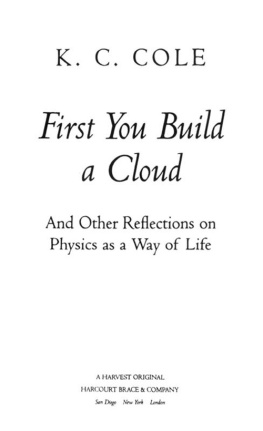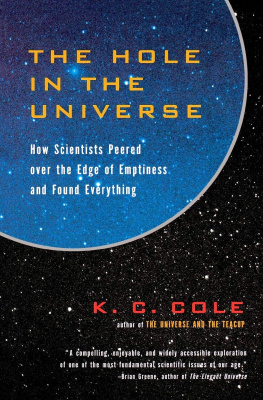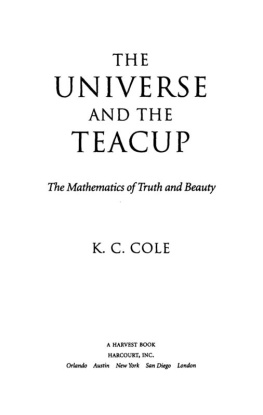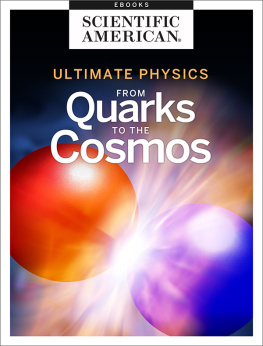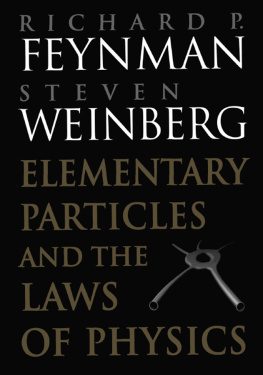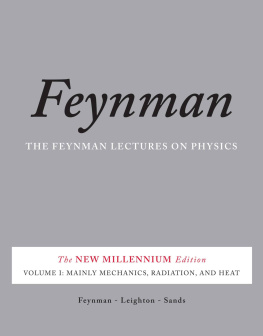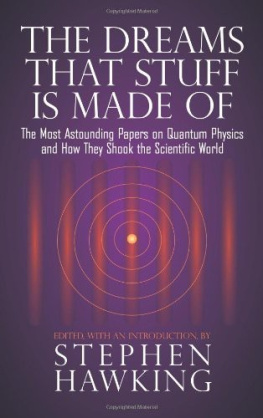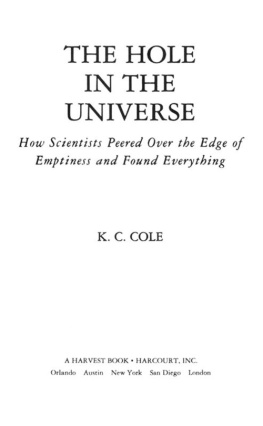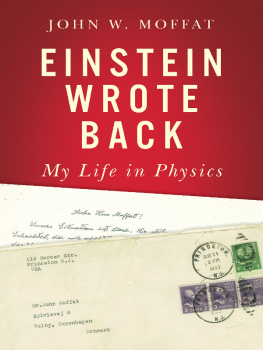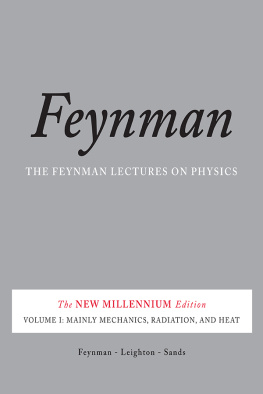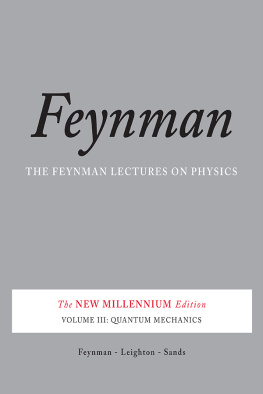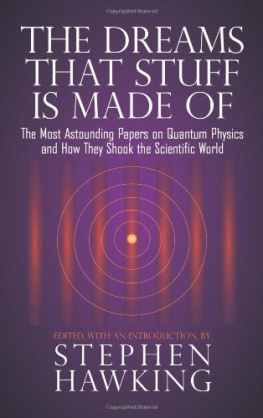Copyright 1999 by K. C. Cole
All rights reserved. No part of this publication may be reproduced or transmitted in any form or by any means, electronic or mechanical, including photocopy, recording, or any information storage and retrieval system, without permission in writing form the publisher.
Requests for permission to make copies of any part of the work should be mailed to: Permissions Department, Harcourt Brace & Company, 6277 Sea Harbor Drive, Orlando, Florida 32887-6777.
Photographs by Nancy Rodger Exploratorium
Library of Congress Cataloging-in-Publication Data
Cole, K. C.
First you build a cloud: and other reflections on physics
as a way of life/by K. C. Cole.Rev. ed.
p. cm.
ISBN 0-15-600646-4
ISBN 978-0-15-600646-0
Originally published: Sympathetic vibrations.
1st ed. New York: W. Morrow, 1985.
Includes index.
I. Physics. I. Cole, K. C. Sympathetic vibrations. II. Title.
QC21.2.C62 1999
530dc21 98-47050
Designed by Linda Lockowitz
Text set in Centaur
Printed in the United States of America
First Harvest edition
E G H F
Newton himself, as well as those ... who attacked him ... would have all alike been amazed at the more recent contention that natural science has nothing to do with "values, that it can and should itself remain "value-free, and that those seeking a direction for human life have nothing to learn from our best knowledge of the nature of things. Even a little science ... is a thing of infinite promise for human values.
J OHN H ERMAN R ANDALL , J R ., Newtons Philosophy of Nature
Physical science used to be called natural philosophy, but unfortunately physics is no longer taught as a course in philosophy. This situation is surprising, because most of the physicists that I know talk with me and with each other with full awareness that the way in which we think of the physical world profoundly shapes the way we think of the human and ethical worlds. For them physics is a part of culture and of philosophy. In the chapters of this book, K. C. Cole has been able to talk to nonphysicists in the thoughtful way that many physicists talk to each other.
F RANK O PPENHEIMER
Founder of The Exploratorium, a museum of science and perception in San Francisco
For Bob Miller
T HIS NEW VERSION of the book formerly known as Sympathetic Vibrations: Reflections on Physics as a Way of Life has been substantially revised. Much new material has been added, and many sections have been dramatically honed or deleted. In addition, the material has been reorganized into three thematic parts.
The introduction, Living in Outer Space, lays out the philosophical framework for the book, and explains certain biases that guide the exposition and tone.
The first part, The Art of Knowing, explores the many approaches physicists take in their attempts to see the unseeable and understand a material universe that may well turn out to be beyond human ken. The second, Movers and Shakers, deals with the forces and pseudoforces that make the world go round, as well as the foundations of modern physics: quantum mechanics and Einsteins special and general theories of relativity. The third, Threads and Knots, follows some of the repeating patterns that weave throughout the physical universe. Some, like sympathetic vibrations, are rhythms that seem to pop up everywhere one looks in nature; others, like the relationship between cause and effect, leave physicists facing knotty problems theyre still trying hard to unravel.
Acknowledgments
I TS A RARE TREAT for an author to get a second crack at an already published manuscript, so special thanks to Jane Isay, my editor at Harcourt Brace, for the chance to turn the book formerly known asSympathetic Vibrations into First You Build a Cloud. I like the book much better now, and I hope she does. Thanks also to Janes assistant, Lorie Stoopack, for good editorial advice and unfailing good humor when I needed it most.
I continue to be grateful to all the editors down the line who encouraged metoexplore the connections between physics and philosophy in popular publications: Phyllis Theroux, who first suggested that I try writing about the unlikely subject of physics as a way of life in four essays for the Washington Post; Nancy Newhouse of The New York Times, for encouraging me to pursue the same subject in a series of seven Hers columns; Leon Jaroff, founding editor of Discover who gave me a column in his magazine; and Evelyn Renold, formerly at Lears, who let me prove the appeal of physics to women who werent born yesterday.
I owe much of this book to my friend the physicist, Frank Oppenheimer, who inspired and encouraged me, and told me what to read and who to talk to. Among those wonderful mentors and teachers were Philip Morrison and Victor Weisskopf. Both Weisskopf and Oppenheimer criticized the first version of this book with great (and ruthless) carefor which I am eternally indebted. Thanks also to the staff of The Exploratoriumespecially the dinosaursa wellspring of inspiration for twenty-five years. And to Nancy Rodgers, for her illuminating photographs.
Finally, I wish to acknowledge the role of Bob Miller, to whom this book is dedicated. Artist, natural philosopher, and great family friend, Bob has taught us about living in outer space and the secret lives of shadows, the universe inside a pinhole and the awesome weight of clouds. Most of all, thanks to Bob for his unflagging vigilance against the pervasive threat he calls hardening of the categories.
Introduction
Living in Outer Space
Books on physics are full of complicated mathematical formulae. But thought and ideas, not formulae, are the beginning of every physical theory.
A LBERT E INSTEIN AND L EOPOLD I NFELD , The Evolution of Physics
The discoveries of science, the new rooms in this great house, have changed the way people think of things outside walls.... It is my thesis that [these discoveries] do provide us with valid and relevant and greatly needed analogies to human problems lying outside the present domain of science or its present borderlands.
J. R OBERT O PPENHEIMER , Science and the Common Understanding
P OPULAR SCIENCE writers are forever proclaiming the profound importance of such matters as the ultimate fate of the universe, or the events that took place during the first trillionth of a second of time. We write as if people were poised on the edges of their proverbial seats, anxiously waiting to learn whether or not the proton will decay (in 1032 years!) or whether there is mass tucked away mysteriously inside neutrinos. Breathlessly, we keep them up to date on such esoterica as the search for the top quark or the "cosmological constant. Sometimes I wonder how many readers struggling to get their socks on in the morning doubt whether exploring these far-out corners of the universe is necessarily so important. It is surely not obviously useful.
But the juiciest mysteries of the universe at large and the innards of the atom are closer to home than we think. Science fiction fantasies describe travels into outer space as if it were some strange and exotic landscape, the site of galaxies far, far away and the possible home of weird creatures. Yet our watery world rolls around all day long in outer space, and at least some of those weird creatures are usmade of flesh and bone and, ultimately, quarks. Outer space is not alien territory. Neither is inner space. Its where we live.
Perhaps more compelling, the ideas of science have seeped into almost every aspect of our language and culture. We speak of people who attract and repel each other (like magnets), of the force of habit, of cause and effect, of disorder and quantum leaps, most of all, of space and time. Our language is liberally sprinkled with the metaphors of scienceand the language of science is inescapably infused with images from everyday life.
Next page
